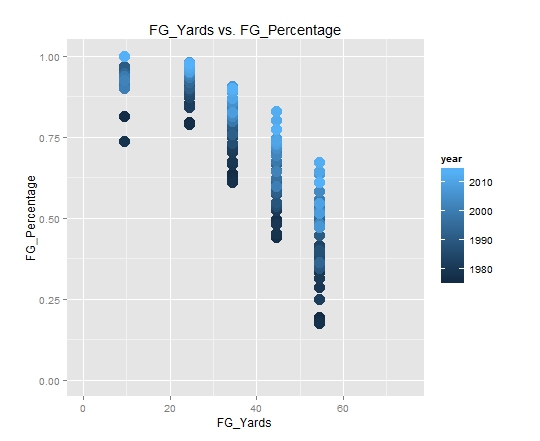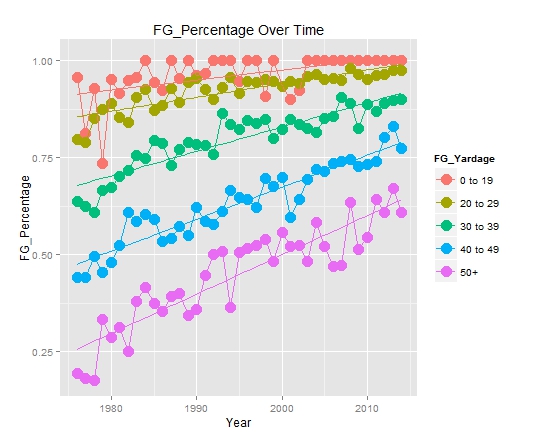Welcome! I intend this to be an ongoing project of predicting NFL game outcomes, point spreads, and final scores. My hope is that my models will improve over time as they become more sophisticated and use better data. I will try to regularly publish predictions to keep myself accountable, and will make observations along the way about what is working and what isn't. See below for latest updates. Enjoy!
Previous predictions
_____________________________________________________________________________________
Recap of Week 8:
My most recent attempt wasn’t great. My predictions went 8-6. Let’s look at what happened:
·
49ers vs. Rams
o
Predicted: 49ers 64% likely to win, but they
lost.
o
Other sites predicted a Ram’s victory. I should have agreed. 49ers have been struggling and had the worst
of the two records going into the game.
Kaepernick is getting benched and Vernon Davis has been traded, so
things are looking really grim for the 49ers going forward. No real injuries I see, so my prediction was
just bad. Especially since the 49ers got
trounced.
·
Packers vs. Broncos
o
Predicted: 64% Packers likely to win, but they
lost.
o
Other sites also favored the Packers. Packers didn’t have any new major injuries. Again, it looks like another missed
prediction, although this time I was on the side of other predictions. Unfortunately, the game wasn’t even close.
·
Falcons vs. Buccaneers
o
Predicted: 65% Falcons likely to win, but they
lost.
o
This game went into overtime, and other sites
thought the Falcons would win too, so I don’t feel too bad. Falcons had a much stronger record and were
playing at home. I’ll call this one
unlucky.
·
Lions vs. Chiefs
o
Predicted: 55% Lions likely to beat Chiefs, but
they lost.
o
Other sites favored the Chiefs, but not by
much. Both teams had pretty bad records,
but the Lions were worse. Lions got
destroyed 45 to 10. Lions were a bit
healthier than in previous games.
Another bad prediction on my part.
·
Jets vs. Raiders
o
Predicted: Jets 53% likely to win, but they
lost.
o
Other sites favored the Jets, and they had a
slightly better record going into the game.
Jets have a lot of injuries on their offense, including their QB. Raiders look comparatively healthy, so perhaps
this can help explain some of the error in prediction (my model does not yet
account for injuries/starters).
·
Titans vs. Texans
o
Predicted: Titans 56% likely to win, but they
lose.
o
Texans were favored to win by other sites and
they had a slightly better record going into the game. Texans look more injured than Titans. So again, another bad call on my part.
I was in agreement with other sites on 3 of these 6
games. It looks like injuries are partly
making a difference, but not by much. I
think in the end, I need better data and a more accurate model as some of my
predictions weren’t even close. We’ll
try again soon.
Week 8: Second Published Predictions (Win/Lose)
Below is the next round of predictions I was able to make. I've been working on cleaning up the code, automating data pulls, creating new features, and making sure I wasn't using any information that was not known prior to the game in building my model. Here are the predictions for week 8:
Week
|
Date
|
Team
|
HomeAway
|
Opponent
|
ProbabilityWin
|
PredictedTeamWin
|
ActualTeamWin
|
8
|
10/29/2015
|
Dolphins
|
@
|
Patriots
|
0.28
|
0
|
0
|
8
|
10/29/2015
|
Patriots
|
Dolphins
|
0.72
|
1
|
1
| |
8
|
11/1/2015
|
49ers
|
@
|
Rams
|
0.64
|
1
|
0
|
8
|
11/1/2015
|
Bears
|
Vikings
|
0.31
|
0
|
0
| |
8
|
11/1/2015
|
Bengals
|
@
|
Steelers
|
0.62
|
1
|
1
|
8
|
11/1/2015
|
Broncos
|
Packers
|
0.36
|
0
|
1
| |
8
|
11/1/2015
|
Browns
|
Cardinals
|
0.34
|
0
|
0
| |
8
|
11/1/2015
|
Buccaneers
|
@
|
Falcons
|
0.35
|
0
|
1
|
8
|
11/1/2015
|
Cardinals
|
@
|
Browns
|
0.66
|
1
|
1
|
8
|
11/1/2015
|
Chargers
|
@
|
Ravens
|
0.38
|
0
|
0
|
8
|
11/1/2015
|
Chiefs
|
Lions
|
0.45
|
0
|
1
| |
8
|
11/1/2015
|
Cowboys
|
Seahawks
|
0.44
|
0
|
0
| |
8
|
11/1/2015
|
Falcons
|
Buccaneers
|
0.65
|
1
|
0
| |
8
|
11/1/2015
|
Giants
|
@
|
Saints
|
0.41
|
0
|
0
|
8
|
11/1/2015
|
Jets
|
@
|
Raiders
|
0.53
|
1
|
0
|
8
|
11/1/2015
|
Lions
|
@
|
Chiefs
|
0.55
|
1
|
0
|
8
|
11/1/2015
|
Packers
|
@
|
Broncos
|
0.64
|
1
|
0
|
8
|
11/1/2015
|
Raiders
|
Jets
|
0.47
|
0
|
1
| |
8
|
11/1/2015
|
Rams
|
49ers
|
0.37
|
0
|
1
| |
8
|
11/1/2015
|
Ravens
|
Chargers
|
0.62
|
1
|
1
| |
8
|
11/1/2015
|
Saints
|
Giants
|
0.59
|
1
|
1
| |
8
|
11/1/2015
|
Seahawks
|
@
|
Cowboys
|
0.56
|
1
|
1
|
8
|
11/1/2015
|
Steelers
|
Bengals
|
0.37
|
0
|
0
| |
8
|
11/1/2015
|
Texans
|
Titans
|
0.44
|
0
|
1
| |
8
|
11/1/2015
|
Titans
|
@
|
Texans
|
0.56
|
1
|
0
|
8
|
11/1/2015
|
Vikings
|
@
|
Bears
|
0.69
|
1
|
1
|
8
|
11/2/2015
|
Colts
|
@
|
Panthers
|
0.34
|
0
|
0
|
8
|
11/2/2015
|
Panthers
|
Colts
|
0.66
|
1
|
1
|
_____________________________________________________________________________________






















